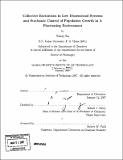| dc.contributor.advisor | Robert J. Silbey. | en_US |
| dc.contributor.author | Xia, Xiang, Ph. D. Massachusetts Institute of Technology | en_US |
| dc.contributor.other | Massachusetts Institute of Technology. Dept. of Chemistry. | en_US |
| dc.date.accessioned | 2007-08-29T20:36:13Z | |
| dc.date.available | 2007-08-29T20:36:13Z | |
| dc.date.copyright | 2007 | en_US |
| dc.date.issued | 2007 | en_US |
| dc.identifier.uri | http://hdl.handle.net/1721.1/38620 | |
| dc.description | Thesis (Ph. D.)--Massachusetts Institute of Technology, Dept. of Chemistry, 2007. | en_US |
| dc.description | Vita. | en_US |
| dc.description | Includes bibliographical references. | en_US |
| dc.description.abstract | In this thesis, I study several problems in the following areas: collective excitations in condensed matter physics, noise in gene network and stochastic control in biophysics. In the first area, I construct an effective field theory to describe Bose-Einstein Condensate (BEC) realized in an external potential. This theory explicitly explores the idea of spontaneous symmetry breaking and its application in the description of phase transitions of confined systems. Based on the effective lagrangian, I calculate the excitation spectrum and Matsubara Green's functions using the method of functional integrals. The theory also shows that in one dimension the collective excitation of a bosonic system can be unified with that of a fermionic system, which is described by Luttinger liquid theory. The unified theory of collective excitations of low dimensional quantum systems motivates my study of collective excitations of interacting classical particles confined in one dimension. It is shown in my paper that the structure of Hamiltonian or Lagrangian for one dimensional constrained systems is uniquely determined by conservation laws. Therefore the excitations of bosonic, fermionic and classical particles are strikingly similar in one dimension. | en_US |
| dc.description.abstract | (cont.) In the second area, i. e., noise in gene networks and phenotypic switching in a fluctuating environment, I study the noise propagation in a gene network cascade using the method of master equations which examines the validity of the more popular methods such as the Langevin equation. To further explore the applications of stochastic processes for complex systems, I study phenotypic switches in a fluctuating environment. By combining the techniques of stochastic differential equation and stochastic dynamical programming, I propose a simple framework which can be used to study phenotypic growth dynamics. Another work is to explore the influence of environment on the dynamical properties of small systems is directed to the unusual blinking statistics of semiconductor quantum dots. I show in a model system that a broad spectrum of decay rates is possible when disorder is present in the environment. | en_US |
| dc.description.statementofresponsibility | by Xiang Xia. | en_US |
| dc.format.extent | 166, [1] p. | en_US |
| dc.language.iso | eng | en_US |
| dc.publisher | Massachusetts Institute of Technology | en_US |
| dc.rights | M.I.T. theses are protected by copyright. They may be viewed from this source for any purpose, but reproduction or distribution in any format is prohibited without written permission. See provided URL for inquiries about permission. | en_US |
| dc.rights.uri | http://dspace.mit.edu/handle/1721.1/7582 | |
| dc.subject | Chemistry. | en_US |
| dc.title | Collective excitations in low dimensional systems and stochastic control of population growth in a fluctuating environment | en_US |
| dc.type | Thesis | en_US |
| dc.description.degree | Ph.D. | en_US |
| dc.contributor.department | Massachusetts Institute of Technology. Department of Chemistry | |
| dc.identifier.oclc | 156995479 | en_US |
